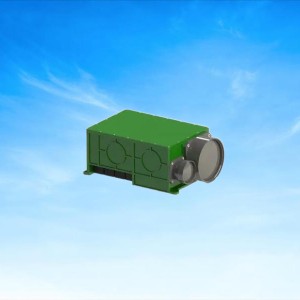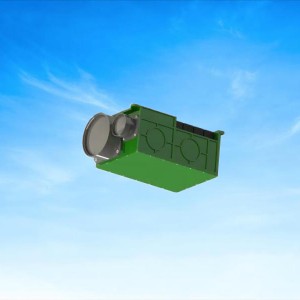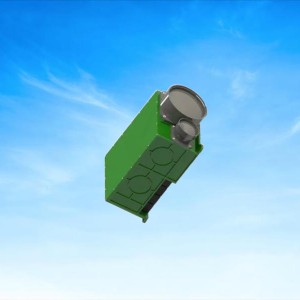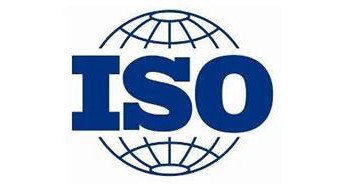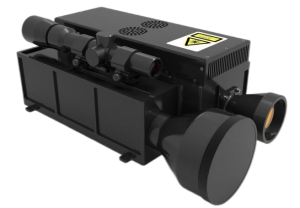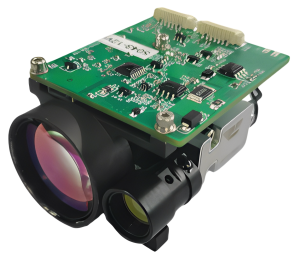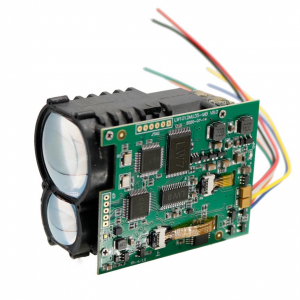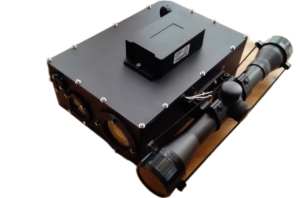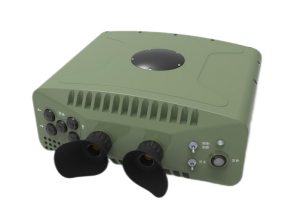1570nm Laser Rangefinder -120K16
Parameter
|
Parameters |
Specification |
||
|
Wavelength |
1570nm |
||
|
Maximum Range |
≥120km |
Ranging from sky to ground |
reflectivity≥0.1 |
|
Altitude of aircraft≥6km |
|||
|
≥16km |
Ranging from ground to sky, target area:0.1㎡ |
reflectivity≥0.3 |
|
|
visibility≥16km |
|||
|
Minimum Range |
≥400m |
||
|
Ranging repetition rate |
≥20Hz |
||
|
Divergence angle |
≤0.6mrad |
||
|
Ranging accuracy |
≤±5m |
||
|
Power supply |
DC 22V~30V |
||
|
Power (under room temperature) |
≤300W |
||
|
Continuous operating time |
≥3min@20hz |
||
|
Operating temperature |
-40℃~+55℃ |
||
|
Storage temperature |
-50℃~+65℃ |
||
|
Dimension |
≤410mm×231mm×161mm(lens cap is not included) |
||
|
Weight |
≤10kg |
||
With bold and clear marks, special design of socket and connectors is tend to protect it from reverse and false connection. For external interface, it adopts military J30J micro-connectors(names vary according to different manufacturers) Socket: XS1
Table 1 and table 2 show the socket and plug of external interface, table 3 shows definition of Pin NO.
Table 1 Socket of external interface of laser rangefinder
|
NO. |
Item |
Model |
Mark |
|
1 |
Socket of power supply and communication interface |
J30JM-15ZKP29 |
XS1 |
Table 2 Plug of external interface of laser rangefinder
|
NO. |
Item |
Model |
Mark |
|
1 |
Plug of power supply and communication interface |
J30J-15TJL–C1(L100) |
XP1 |
Table 3 Definition of Pin NO.
|
PIN NO. |
Abbr. |
Note. |
Definition |
|
1 |
PWR+ |
DC,28V+ |
|
|
2 |
PWR+ |
DC,28V+ |
|
|
3 |
PWR+ |
DC,28V+ |
|
|
4 |
PWR+ |
DC,28V+ |
|
|
5 |
RTN_P |
DC,28V- |
|
|
6 |
RTN_P |
DC,28V- |
|
|
7 |
RTN_P |
DC,28V- |
|
|
8 |
RTN_P |
DC,28V- |
|
|
9 |
LRF_COM_T+ |
RS422(COM)Y |
Laser rangefinder transmit+ |
|
10 |
LRF_COM_T- |
RS422(COM)Z |
Laser rangefinder transmit- |
|
11 |
LRF_COM_R- |
RS422(COM)B |
Laser rangefinder receive- |
|
12 |
LRF_COM_R+ |
RS422(COM)A |
Laser rangefinder receive+ |
|
13 |
GND_ LRF_COM |
RS422(COM)GND |
|
|
14 |
LRF_ Trigg_R+ |
external trigger receive+ |
|
|
15 |
LRF_ Trigg _R- |
external trigger receive- |
Targets and condition requirements
Ranging ability: 120km(ranging from sky to ground, reflectivity:≥0.1, Altitude of aircraft:≥6km)
Ranging ability:≥16km(ranging from ground to sky, target area:0.1㎡, reflectivity:≥0.3, visibility≥16km)
Analysis and verification
The main parameters that affect ranging ability are peak power of lasers, divergence angle, transmitting and receiving transmittance, wavelength of laser, etc.
For this laser rangefinder, it takes≥10MW peak power of lasers, 0.6mrad divergence angle, 1570nm wavelength, transmitting transmittance≥90%, receiving transmittance≥80% and 140mm receiving aperture.
It is a laser rangefinder for small targets, ranging ability can be calculated by the following formula. Ranging formula for small targets:
With 6km flying altitude and 145km distance to targets, the minimum detectable power is lower than M.D.S of APD(5×10-9W), therefore, under a condition with 6km flying altitude, a laser rangefinder can range distance for large targets(from sky to ground) up to 140~145km(might be close or less than 145km).
With bold and clear marks, special design of socket and connectors is tend to protect it from reverse and false connection. For external interface, it adopts military J30J micro-connectors(names vary according to different manufacturers) Socket: XS1
Table 1 and table 2 show the socket and plug of external interface, table 3 shows definition of Pin NO.
Table 1 Socket of external interface of laser rangefinder
|
NO. |
Item |
Model |
Mark |
|
1 |
Socket of power supply and communication interface |
J30JM-15ZKP29 |
XS1 |
Table 2 Plug of external interface of laser rangefinder
|
NO. |
Item |
Model |
Mark |
|
1 |
Plug of power supply and communication interface |
J30J-15TJL–C1(L100) |
XP1 |
Table 3 Definition of Pin NO.
|
PIN NO. |
Abbr. |
Note. |
Definition |
|
1 |
PWR+ |
DC,28V+ |
|
|
2 |
PWR+ |
DC,28V+ |
|
|
3 |
PWR+ |
DC,28V+ |
|
|
4 |
PWR+ |
DC,28V+ |
|
|
5 |
RTN_P |
DC,28V- |
|
|
6 |
RTN_P |
DC,28V- |
|
|
7 |
RTN_P |
DC,28V- |
|
|
8 |
RTN_P |
DC,28V- |
|
|
9 |
LRF_COM_T+ |
RS422(COM)Y |
Laser rangefinder transmit+ |
|
10 |
LRF_COM_T- |
RS422(COM)Z |
Laser rangefinder transmit- |
|
11 |
LRF_COM_R- |
RS422(COM)B |
Laser rangefinder receive- |
|
12 |
LRF_COM_R+ |
RS422(COM)A |
Laser rangefinder receive+ |
|
13 |
GND_ LRF_COM |
RS422(COM)GND |
|
|
14 |
LRF_ Trigg_R+ |
external trigger receive+ |
|
|
15 |
LRF_ Trigg _R- |
external trigger receive- |
Targets and condition requirements
Ranging ability: 120km(ranging from sky to ground, reflectivity:≥0.1, Altitude of aircraft:≥6km)
Ranging ability:≥16km(ranging from ground to sky, target area:0.1㎡, reflectivity:≥0.3, visibility≥16km)
Analysis and verification
The main parameters that affect ranging ability are peak power of lasers, divergence angle, transmitting and receiving transmittance, wavelength of laser, etc.
For this laser rangefinder, it takes≥10MW peak power of lasers, 0.6mrad divergence angle, 1570nm wavelength, transmitting transmittance≥90%, receiving transmittance≥80% and 140mm receiving aperture.
It is a laser rangefinder for small targets, ranging ability can be calculated by the following formula. Ranging formula for small targets:
With 6km flying altitude and 145km distance to targets, the minimum detectable power is lower than M.D.S of APD(5×10-9W), therefore, under a condition with 6km flying altitude, a laser rangefinder can range distance for large targets(from sky to ground) up to 140~145km(might be close or less than 145km).



